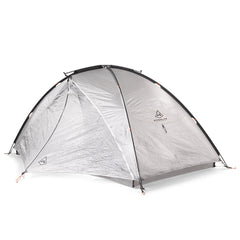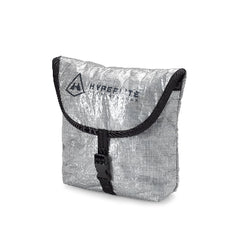Hyperlite Mountain Gear Ambassador Brad Meiklejohn keeps his downtime to a minimum as he moves through the seasons with time-tested transitional habits.
Brad Meikeljohn has an unquenchable thirst for wild places, and he prefers to get into them in an ultralight, minimalist fashion. However, different seasons have different demands, and mimicking some of the easier-to-come-by benefits that Summer offers throughout the rest of the year requires a range of adjustments across the board. He took a moment to walk us through his process.
Fall comes on fast in Alaska. After a Summer of endless days, the first September trip has me rooting around in the bottom of my kit for the headlamp that I set aside in April. The abrupt transition to Fall, with much shorter days, very dark nights with frost, and rain verging on snow snaps me back to a more diligent review of my gear. Summer is gentle on fools; Autumn is unforgiving.
Weather
I don’t pay much attention to weather forecasts in the Summer because I know that conditions will be within a somewhat predictable range. It’s not likely to snow, it doesn’t get very dark, or very cold, and at the worst, it may just be a rainy trip. With the long days of Summer, I can keep moving and be fine. Rarely does the weather forecast shape what trip I take.
Fall is the opposite. I’m picky about which trips I do when and where, tailoring the outing to match the conditions. Our weather forecasts in Alaska are rather unreliable beyond a few days, but it’s usually is easy to tell when we are in a dry cycle versus a wet cycle. If it’s a wet cycle, my trips tend to be rather short, whereas in a dry cycle, I’ll venture out for longer periods.

Shelter
Longer Autumn nights and the prospect of wetter weather call for a different shelter configuration. I’ll swap out the bug liner for a built-in floor or a ground tarp and take a slightly larger shelter. You can get away with four people in a four-person shelter in Summer, but more gear and wetter tent walls in Fall call for more elbow room. A ground tarp that you can move aside makes in-tent cooking (and heating) easier than a built-in floor. Be sure to ventilate moisture and stove combustion out of the shelter properly.
In the Fall, I pay more attention to where I pitch camp than the casual days of Summer. I’m looking for a spot with more protection from wind and some tree canopy to trap heat and block rain or snow. I like to set up out of the valley bottom where the coldest air settles, preferably on a higher bench that is not on a movement corridor for bears, moose, and wolves (“BMW trails” in Alaska-speak).
On clear nights where the bottom falls out of the thermometer, I like to bury the embers of my campfire and pitch the shelter on top for all-night radiant heating.
The ground you pick to sleep on makes a big difference in staying warm. Riverside gravel bars are surprisingly cold, but if that’s all you’ve got to choose from, a layer of sand (especially hot sand) will help. Loose duff under a tree will be much warmer to sleep on than hard compacted ground. I switch out the Summer ultralight air mat for a closed-cell or insulated pad for warmer Fall sleeping. I’ll often roll my packraft out as an added layer of sleeping insulation, and even lay my lifejacket and pack down for really cold nights.

Clothing
It’s easy enough just to dump more stuff in your pack in Fall, but that defeats the idea of fast and light. Instead, I try to trade items out, aiming to keep my kit near the same weight and volume regardless of season.
I revisit my clothes selection in Fall, swapping out ultrathin base layers for lightweight wool, picking any top with a hoody and finger mitts over one without, and trading a rain shell for a real raincoat. I will keep a dedicated sleep layer of all wool, from socks to hat, in a dedicated waterproof Stuff Sack with my sleeping bag and puffy jacket. Since I’m mostly a packrafter, I add in fleece shorts for added diaper effect under my paddling dry suit.
Food
Fall food is focused on fat calories. Carbs are fine for the long days of movement in Summer, but fat-heavy fuel allows me to sleep warm in Fall. Heavy doses of cheese, meat, and peanut butter replace the pasta and bread of Summer.
I try to fool myself a bit by eating lots of ice cream and pizza in between Fall trips. That allows me to eat off my body, burning stored body fat and reducing the weight of food I carry. I try to live off my body for the first few days of a long trip to stretch my food rations.
“I am a packrafter because I love the combination of hiking and floating. In Alaska, without a packraft, the trip possibilities are rather short, but packrafts open up the country. The challenge of packrafting is that you add boating gear on top of backpacking gear, and your pack weight can quickly get out of control. The trick is to be ruthless about not packing your insecurities and finding gear that performs more than one purpose. For years I’ve been dreaming of a titanium paddling helmet that can serve as a cookpot, but my friends think that will make me a pothead!” – Brad Meiklejohn























